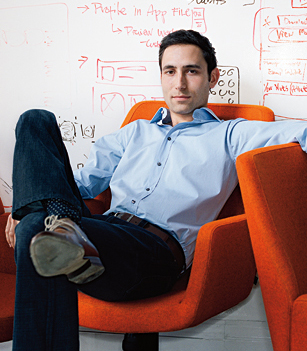
We exchanged the first email with Scott Belsky, the founder of Behance, over his tweet quoting a saying from the article we published on How Influencers Use Email. One thing led to another, the email thread became longer. Eventually I had to ask him a number of questions I've been dying to ask since I heard about Behance the first time years ago. The following is our Q&A about the product challanges and takeaways from building Behance. Enjoy!
Your mission is to organize the creative world. Why? How?Behance was inspired by a sense of frustration. There is SO MUCH discussion in the creative world about inspiration and creativity, but very little discussion about organization and execution. The stuff that makes our lives interesting - the art, the design, and all of the original content - is all created by the creative professional community. But, unfortunately, creatives face unique obstacles when it comes to actually making their ideas happen.
We created Behance with a very specific mission: To organize and empower the creative world. We are NOT trying to increase creativity. On the contrary, we are trying to help creative leaders harness their own creativity and take the reigns on their careers. We want to boost efficiency for people as they market their talent and manage their portfolios. We want to promote "creative meritocracy" - where the best talent gets matched with the best opportunities.
We developed the Behance Network as a powerful platform to search and sort the creative world's work. Our new service, ProSite (launching soon), is the most advanced personal portfolio site creation tool on the web - and it syncs with a user's Behance projects
Over time, the Behance Network will empower careers and usher an era where talent around the world can be watched, found, hired, and managed by great companies, journalists, and fans.
What were some of the initial challenges building Behance?The hardest part was building something from nothing. I remember the early days in 2006 when Behance was nothing more than a logo and brand identity discussion with my co-founder and long time business partner Matias Corea. When the site launched, we invited people to experiment with the system. Behance is optimized to provide the maximum exposure for a user's work. It would have failed if it didn't deliver results.
The greatest challenge was getting the word out to the RIGHT people. At Behance, we are more focused on QUALITY than quantity. Membership in the site is still sought via invitation. If we made it automatic to join it would be a lot bigger, but we only want members that are serious about their careers in the creative world.
What would you say was the driving factor in building a vibrant community for you?The driving factors for building a vibrant community were:
- Featuring the WORK before the people. Behance is all about the work and the presentation, not about your name, avatar, or who you know.
- Meritocracy: We have all sorts of algorithms that allow us to watch the "community curation" and identify new and amazing work that should be featured. We are also developing new sites like TypographyServed.com, ToyServed.com, and others that feature great work in specific verticals selected by professional curators.
Actually, Seth Godin also does email - and makes a point of responding to every email that he receives. I really admire this effort (and philosophy). If your career is all about building and serving a community then you better make time to answer peoples' questions. Sometimes it takes me a while, but I try to answer every email that I receive. I don't respond to things on Facebook as much. However, I do make an effort to answer thoughtful (and quick) questions on Twitter and, of course, on the Behance Network.
You need to fiercely protect your time, but there is no reason not to respond to people and thank them for their feedback or comment.
What are your own top three best practices you recommend in building a community.- Address a communal need, not your own desire. Too many communities are founded on a philosophy rather than addressing a problem.
- Don't reinvent the wheel. Do research and make sure you're doing something that is both new and better.
- Experiment and listen. A community must always be optimized, and feedback must always be considered.